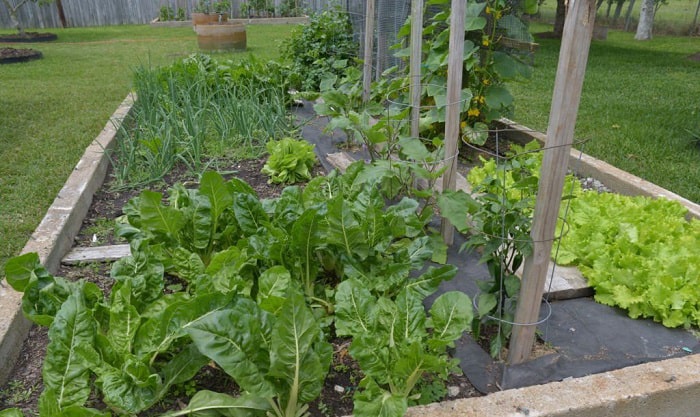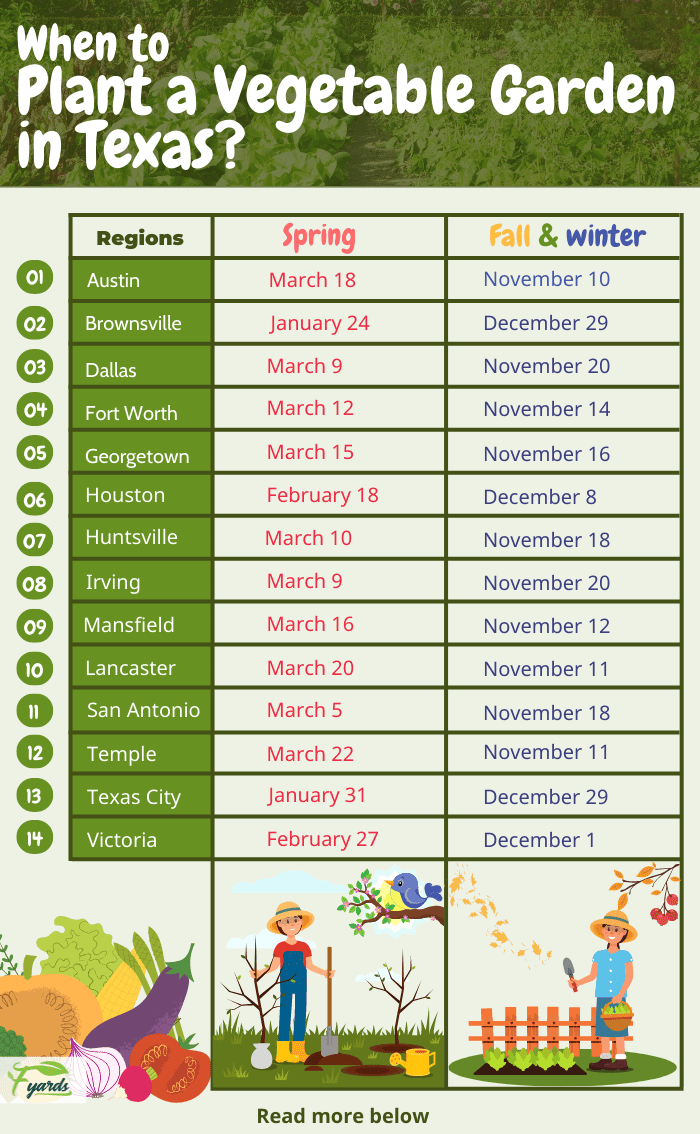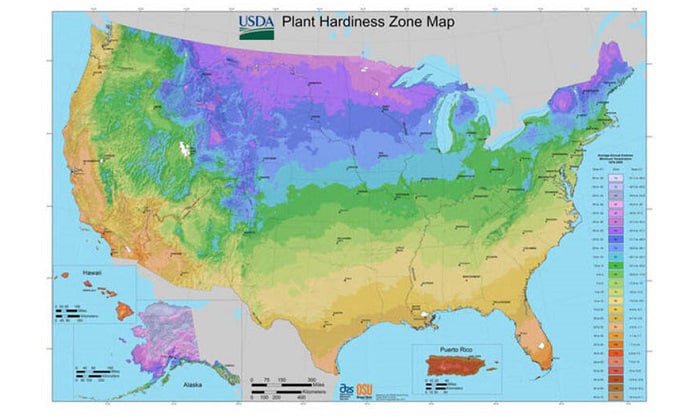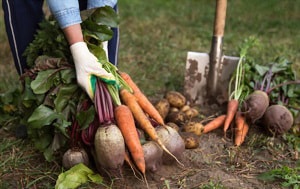Timing plays a pivotal role in cultivation. If you start planting when the weather is too hot or cold, your vegetables may not survive, let alone thrive.
As someone who lives in the Lone Star State, you’ve probably asked yourself, “when to plant a vegetable garden in Texas?”
Generally, the growing season in Texas spans January 1st to October 15th, but these dates can vary. For example, the beginning of the planting period may not start until mid-April, and its end can fall between October 15th and December 31st. Read below for more info.
Table of Contents
When to Start Planting in Texas?
1. Spring
The best time to plant a spring garden in Texas is when the last frost date of the season ends. As stated above, it may fall within January to April.
To find this date for your location, you can enter your zip code on almanac.com. But for quick reference, here are the last spring frost days for some regions in Texas:
- Austin – March 18
- Brownsville – January 24
- Dallas – March 9
- Fort Worth – March 12
- Georgetown – March 15
- Houston – February 18
- Huntsville – March 10
- Irving – March 9
- Mansfield – March 16
- Lancaster – March 20
- San Antonio – March 5
- Temple – March 22
- Texas City – January 31
- Victoria – February 27
- Note that the above are only estimates, so it’s best to check the weather forecasts for your location. If the temperature is 32 degrees Fahrenheit or under, don’t start gardening just yet.
Plus, to be safe, delay your Texas planting schedule by two weeks. That way, if a spring frost comes later than predicted, it won’t destroy your vegetables.
2. Fall and winter
Fall/winter is the second planting season in Texas. To grow foods successfully in this period, you need to sow seeds in July (at the earliest) or October (at the latest).
Check out the days of the first fall or winter frost for some Texas regions below. Your vegetables should finish maturing and get harvested by then.
At the same time, look up how long it takes your plants to grow and sow seeds accordingly. For example, radishes can mature in a month, so if your first autumn frost is on November 18, you need to plant these root veggies on October 18 at the latest.
Similar to the spring schedule, you can find the fall ice dates for your locality on almanac.com.
- Austin – November 10
- Brownsville – December 29
- Dallas – November 20
- Fort Worth – November 14
- Georgetown – November 16
- Houston – December 8
- Huntsville – November 18
- Irving – November 20
- Mansfield – November 12
- Lancaster – November 11
- San Antonio – November 18
- Temple – November 11
- Texas City – December 29
- Victoria – December 1
Vegetables to Grow in Texas
In addition to the frost dates, the type of flora you want to grow will influence when you plant seeds in Texas.
We have listed the gardening times for some common vegetables, sorted by zones I to V.
- Zone 1 corresponds to USDA hardiness zone 6 (which includes places like Adrian, Booker, and Amarillo).
- Similarly, zone 2, which includes Lubbock and El Paso, corresponds to USA hardiness zone 7.
- Zone 3 is hardiness zone 8 and covers Dallas, Austin, Houston, and San Antonio, among others.
- Zone 4, also known as hardiness zone 9a, spans regions like Laredo, Corpus Christi, and Charlotte.
- Lastly, zone 5 or hardiness zone 9b has McAllen, Medina, Palm Valley, and more.
1. Planting season in spring
Find out when to start growing certain vegetables in the spring below:
| Zone 1 | Zone 2 | Zone 3 | Zone 4 | Zone 5 | |
| Broccoli | March 1 – June 15 | February 15 – March 20 | February 1 – March 1 | January 15 – February 25 | January 1 – February 15 |
| Carrots | March 10 – mid-April | February 15 – March 10 | January 15 – March 1 | January 15 – March 10 | January 1 – February 1 |
| Sweet corn | April 1 – May 20 | March 15 – May 1 | February 25-
May 1 |
February 15 – March 15 | February 1-
March 15 |
| Asparagus | March 2 and after | February 16 and after | February 2 and after | January 16 and after | Not applicable |
| Brussel sprouts | February 15 – April 1 | February 15 – March 1 | Not applicable | Not applicable | Not applicable |
| Cucumber | April 15 – June 1 | April 1 – May 15 | March 5 – May 1 | February 1 – April 10 | February 1 – April 1 |
| Potato | March 15 – April 7 | March 10 – April 1 | February 15 – March 1 | January 15 – February 15 | Same as carrots |
| Spinach | March 1 – April 1 | February 1 – March 1 | January 1 – February 15 | Same as zone 3 | Same as carrots |
| Onion and parsley | March 1 – April 15 | Same as carrots | February 1 – March 1 | January 15 – February 10 | Same as carrots |
Notes:
- It’s possible to start the garden planting calendar earlier by growing vegetables indoors and transplanting them outdoors 10 days to two weeks after the last spring frost date.
For instance, you can put broccoli, spinach, and tomatoes into small pots at the end of December or early January. Once the temperature becomes warm enough, you can transfer them into garden beds.
- Note that the soil and surrounding air must be 60 to 70 degrees Fahrenheit. Otherwise, the plants may die, whether they’re inside your home or outside.
- Some flora, such as beans, watermelons, and sweet corn, are very difficult to transplant, as you cannot discard their containers. For these species, it may be better to follow the dates above and plant them directly into the ground outdoors.
2. Planting season in fall
Now that you know the spring planting dates for some vegetables, find out when to start gardening in Texas in the fall, taking into account the species you want to grow.
Zone 1
You can plant beans, broccoli, cabbage, carrots, cucumber, cauliflower, peas, and winter squash from July 15.
In August, swiss chard, collards, and summer squash may be grown from the first day of the month; meanwhile, spinach, kohlrabi, and beets must wait until mid-August.
It’s possible to plant lettuce, mustard, and radish on September 1, and two weeks later, one can work on parsley.
Zone 2
You can grow winter squash, pumpkin, and southern peas on July 1. 30 days afterward, broccoli, brussel sprouts, cucumber, and cauliflower can be planted.
In addition, flora like spinach, kohlrabi, and beets can start thriving in September, while mustard, parsley, and radish will need to wait until October.
Zone 3 – Some dates for different vegetables in this area are:
- July 1 – tomato, pepper, eggplant.
- August 20 – Lima beans, sweet corn.
- October 10 – collards, lettuce, parsley.
- November – turnip (November 1), carrots (November 10), spinach (November 15), and radish (November 25).
Zone 4 – This region can accommodate the following fall vegetables:
- July – tomato, eggplant (July 10), and pepper (July 15).
- August – pumpkin (August 10), southern peas (August 15).
- September – Lima beans, winter squash.
- October – broccoli, cabbage, cauliflower, potato, summer squash (October 1), collards, and Swiss chards (October 20).
- November – beets, garlic, lettuce, parsley.
- December – turnip, radish, spinach, mustard, and onion.
Zone 5
Gardeners can grow tomatoes, eggplants, and pepper in August. In September, southern peas, Lima beans, and pumpkin may be planted.
Later in October, summer squash and cucumber will be able to thrive, and from this month until the end of the year, one can continue Texas gardening in zone 5.
November plants include kohlrabi, broccoli, and cabbage. Finally, beets, carrots, and collards can be grown from mid-December.
Conclusion
When to plant a vegetable garden in Texas? You should now know the answer. No matter where you live, it’s important to check the frost dates and take into account the flora you want to grow. That way, you can determine the correct time to start planting and harvesting.
If you find this article helpful, please share it with other people. Thanks for reading!

Hi, I am William – Floridayards’ digital content creator. My job is to find answers to all your concerns with thorough research and our team’s expert advice. I will also bring you honest reviews on the best products and equipment for raising your beautiful garden. Please look forward to our work!















